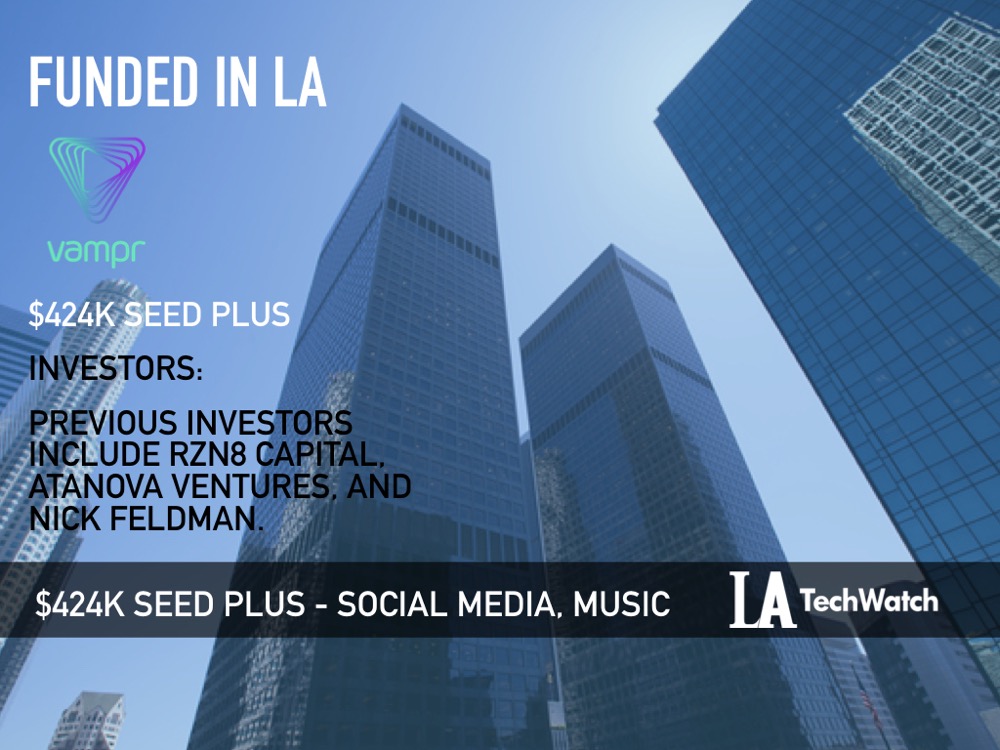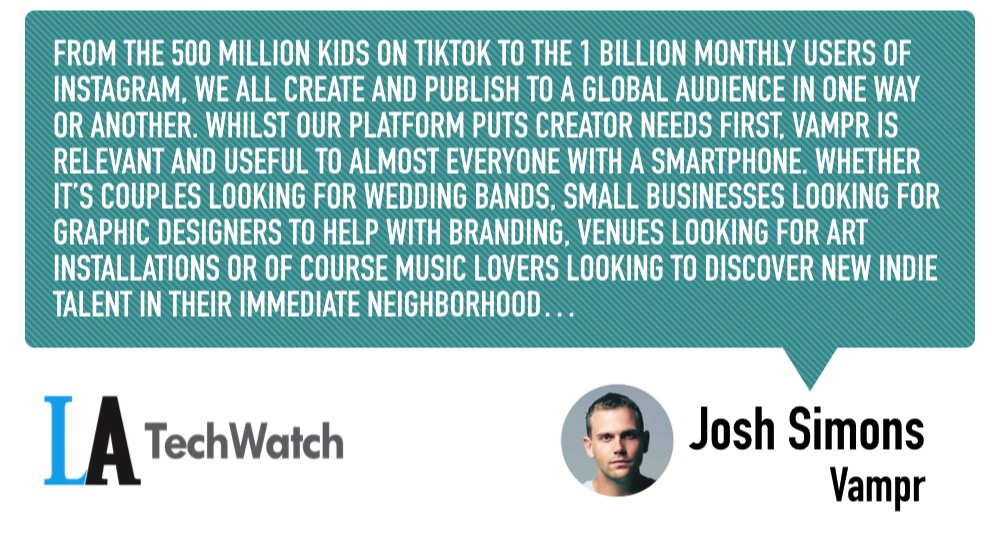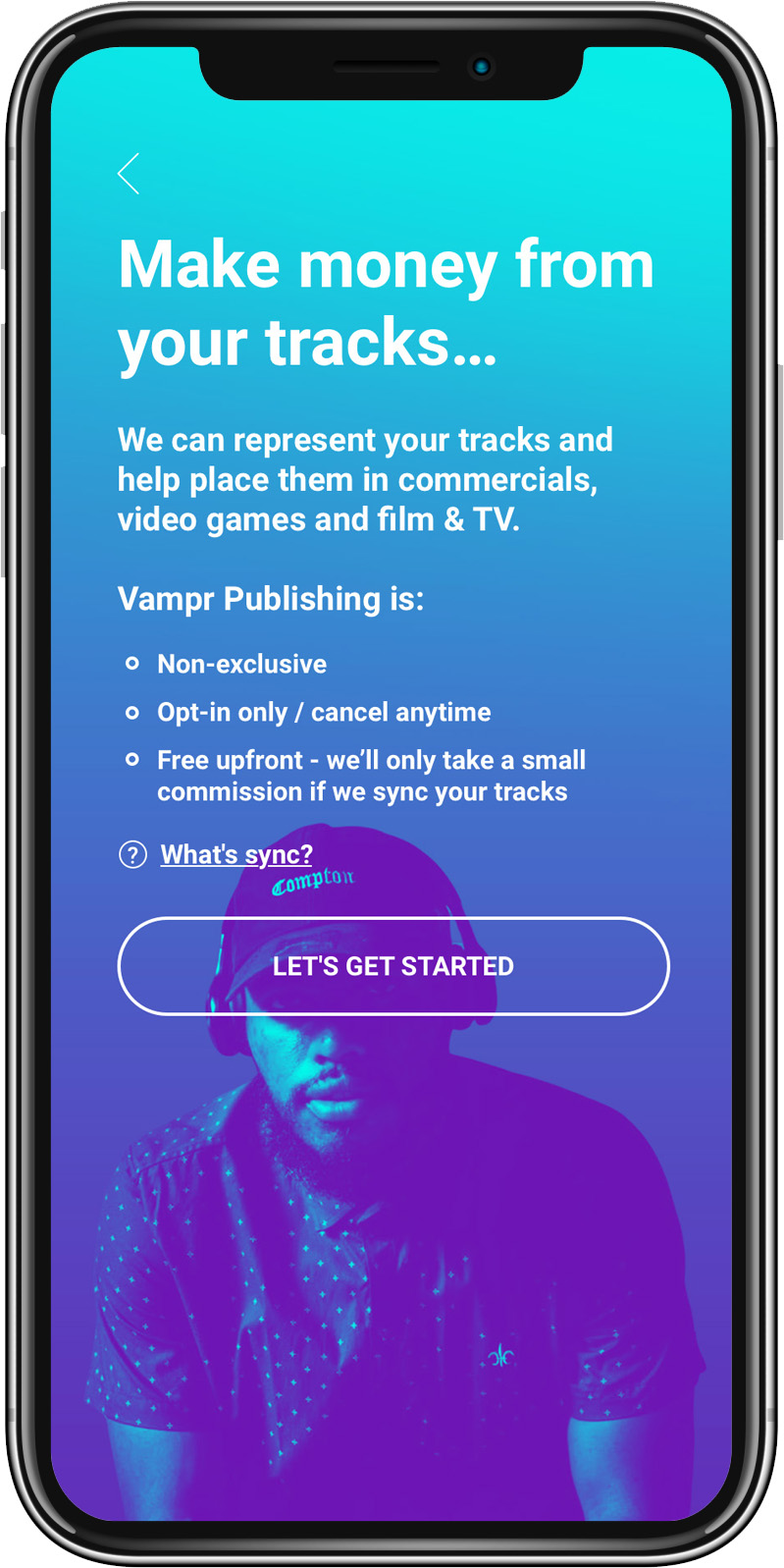Platforms like TikTok and Instagram have given creatives a completely new way to share and create content; however, there still lacks an official infrastructure to help creatives professionally network. Vampr fixes that problem with its professional networking platform designed specifically for creatives and musicians. Unlike its competitors, Vampr is a mobile-first platform that gamifies networking in order to make it fun and appealing. Vampr has also launched a publishing platform focused on helping unrepresented artists monetize. Interested parties can license a diverse catalog of music from unrepresented artists in a few clicks. Currently, there are roughly 500 independent artists in the catalog.
LA TechWatch caught up with CEO and Cofounder Josh Simons to learn more about Vampr and how it’s differentiating itself from other creative networking platforms. To date, Vampr has raised approximately $1.9M across three rounds.
Who were your investors and how much did you raise?
We positioned this round as a Seed Plus.
Approximately 50% of the funds raised in this round came from a crowdfunding campaign, which we ran concurrently alongside a more traditional Reg D raise.
In total, we ended up attracting around 1,150 investors from over 50 countries and all walks-of-life ranging from institutional investors, music industry veterans, stay-at-home parents, to NHL players.
Tell us about the product or service that Vampr offers.
Vampr is similar to LinkedIn but tailored specifically towards musicians and creative types, where the ability to assess one’s look, feel, and skill is considered exponentially more valuable than scrolling through someone else’s resume.
 What inspired the start of Vampr?
What inspired the start of Vampr?
My cofounder, Baz Palmer, and I, each separately spent about a decade finding our ‘musical tribe’ – the group of people we’d ultimately go on to make money with in the world of music. This is a universal and seriously-time-consuming-and-expensive struggle felt by 99.9% of all musicians – including many of the most successful of all time. Finding good people isn’t quick or easy.
We began asking ourselves: how can we use technology to exponentially lower these hurdles for the next generation of musicians? It didn’t hurt that we’d already worked together quite closely for five years prior to launching Vampr, in the role of the artist (myself) and label boss (Baz).
How is Vampr different?
Vampr has taken the language of some of the most popular ‘meet platforms’ such as Tinder and LinkedIn and applied this approach to the world of music, which has been begging for a tech solution to connect the community since the collapse of MySpace. Most attempts to recapture that magic have involved lackluster scrolling features and many desktop-oriented solutions. From the outset, we decided we’d make Vampr mobile-first, instantaneous in every possible respect, multi-lingual, and perhaps most importantly: fun. Networking sucks – we’re trying to make it more interesting.
What market is Vampr targeting and how big is it?
Every person on the planet interacts or intersects with creativity on a daily basis. From the music we hear on the radio to the movies we watch on Netflix right through to the billboards we see on the street, there is a list as long as your arm of professionals involved in its creation. With earlier iterations of Vampr, we focused on acquiring the professional, semi-professional, and hobbyist creatives. But the reality is that we live in an era where we are all creatives. Smart-phone technology and social networks have turned us all into producers and consumers of content, or ‘prosumers’. From the 500 million kids on TikTok to the 1 billion monthly users of Instagram, we all create and publish to a global audience in one way or another. Whilst our platform puts creator needs first, Vampr is relevant and useful to almost everyone with a smartphone. Whether it’s couples looking for wedding bands, small businesses looking for graphic designers to help with branding, venues looking for art installations, or of course music lovers looking to discover new indie talent in their immediate neighborhood; these are just a few examples of the way people already use Vampr. This consumer demographic will be increasingly important as Vampr scales.
Who do you consider to be your primary competitors?
We identify our competitors in two categories.
Category 1 competitors are the startups trying to solve the exact problem we are trying to solve (Jammcard, Reverbnation, Ryse Up, etc). Aside from product differentiators, scale is the ultimate defensibility and differentiator in our social network sector (no one wants to show up at an empty party!) On the mobile adoption front we are well ahead of all these competitors.
With respect to product, most of these startups have taken a list-based approach to networking and personnel discovery (ie. scrolling, Web 1.0, desktop, etc) which lacks the edge and modern approach we have taken with Vampr – it also lacks any element of fun, whereas Vampr has helped to gamify networking.
Category 2 competitors are the household name platforms that musicians and the industry use to discover new music – YouTube and SoundCloud. They focus predominantly on consumers of music. They are not interested in our core business or business models; however, as Vampr continues to scale and prove its value they may take an interest. Our main concern with this category of companies is a heavily financed start-up creating and marketing an inferior product, which will taint the Vampr concept and turn people off networking this way.
What’s your business model?
On a high level, it can be summed up as primarily subscription, where we’ll be offering a premium tier of the product, whilst continuing to work with creative brands to run ads for users on the freemium tier. We also just announced a new Publishing/Rights Management division of the company, which we’ll be running on a somewhat separate P&L until we validate the B2B concept. This may well eclipse our projections for subscription and advertising, but it’s too early to say.
What was the funding process like?
It was frankly exhausting driving a public raise (Reg CF) alongside a private Reg D offering. Between flying around the States meeting accredited investors in person, to responding to concerned Crowd SAFE investors at 6 AM, this round really kicked our asses! It was a very long six-month process for the company – but it was worth every second of pain, as we’re now innovating again, and we’re innovating better, quicker, and more cost-effectively. I love this job.
What are the biggest challenges that you faced while raising capital?
‘Selling’ or pitching is always an uncomfortable role when your main priority is to innovate and create for the benefit of others; however, in this round, I found the closing and collecting period to be as challenging and exhausting as the selling part! The entire process of raising capital is rather challenging to state the obvious, especially if you didn’t go to Yale or have access to that sort of network. However, if you have a solid story, solid runs on the board, and you take the time to learn how to communicate that story in a linear and simple manner, you probably have the foundations to go and raise capital.
What factors about your business led your investors to write the check?
Domain expertise and market share. I also proved myself as a committed founder who doesn’t take no for an answer and who wants to win at all costs. It’s important to let your personality shine with your investors, but it’s best to let that happen naturally over the course of getting to know one another rather than trying to shoehorn everything into your first pitch.
It’s important to let your personality shine with your investors, but it’s best to let that happen naturally over the course of getting to know one another rather than trying to shoehorn everything into your first pitch.
What are the milestones you plan to achieve in the next six months?
- Generate first revenues from our new publishing/sync catalog
- Release the premium subscription version of Vampr.
We’ve been testing both with select users over the past few weeks and the reaction has been out-of-this-world incredible! We can’t wait to see these new products out there and available in the market.
What advice can you offer companies in Los Angeles that do not have a fresh injection of capital in the bank?
If you’re a tech startup, especially a brand-new tech startup, go and find a technical cofounder, or learn how to code. Having that resource on your team will be essential if you run out of cash. And believe me when I say you don’t want to be just starting out on solving either of those critical problems if you hit some rough patches (which you inevitably will).
Where do you see the company going now over the near term?
Between subscription, publishing, and launch a new version of Vampr, there’s a 6-month product roadmap that every single Vampr user, new or returning, can get excited about. Baz and I have never had more fun or felt more inspired by running this company.
You are seconds away from signing up for the hottest list in Los Angeles Tech! Join the millions and keep up with the stories shaping entrepreneurship. Sign up today






